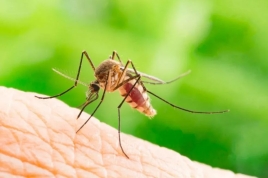108 confirmed West Nile fever cases, 2 deaths in Armenia
Thursday, September 5, 2024
108 cases of West Nile fever have been recorded in Armenia so far; the death toll is 2, according to healthcare minister Anahit Avanesyan.
Avanesyan told reporters that there is no trend of decrease in the new cases so far.
In addition to the application of standard protocols for prevention, authorities have been carrying out anti-epidemic measures in reservoirs and other areas, she said.
Avanesyan highlighted the fact that Armenian authorities introduced and adapted the testing and standard protocols for West Nile fever since day one. “We are doing everything to not have a growth in numbers, but to decrease the numbers,” Avanesyan said.
The West Nile virus, which is spread by mosquitoes and then causes the West Nile fever in humans through bites, was first detected in mosquito samples in Aragatsotn province.
Mosquitos were examined for the virus in Armenia in the 1980s, however, no virus was detected back then. The studies resumed only in 2023, and in the end of July of 2024 the virus was found in five mosquitoes in Aragatsotn province.
The first human case was diagnosed on August 7, and passed a verification test and confirmed on August 10.
According to the World Health Organization, human infection of the West Nile virus is most often the result of bites from infected mosquitoes. Mosquitoes become infected when they feed on infected birds, which circulate the virus in their blood for a few days. The virus eventually gets into the mosquito's salivary glands. During later blood meals (when mosquitoes bite), the virus may be injected into humans and animals, where it can multiply and possibly cause illness. A very small proportion of human infections have occurred through organ transplant, blood transfusions and breast milk. There is one reported case of transplacental (mother-to-child) WNV transmission. To date, no human-to-human transmission of WNV through casual contact has been documented, and no transmission of WNV to health care workers has been reported when standard infection control precautions have been put in place.
The disease is caused by the West Nile Virus (WNV).
Infection with WNV is either asymptomatic (no symptoms) in around 80% of infected people, or can lead to West Nile fever or severe West Nile disease.
About 20% of people who become infected with WNV will develop West Nile fever. Symptoms include fever, headache, tiredness, and body aches, nausea, vomiting, occasionally with a skin rash (on the trunk of the body) and swollen lymph glands.
The symptoms of severe disease (also called neuroinvasive disease, such as West Nile encephalitis or meningitis or West Nile poliomyelitis) include headache, high fever, neck stiffness, stupor, disorientation, coma, tremors, convulsions, muscle weakness, and paralysis. It is estimated that approximately 1 in 150 persons infected with the West Nile virus will develop a more severe form of disease. Serious illness can occur in people of any age, however people over the age of 50 and some immunocompromised persons (for example, transplant patients) are at the highest risk for getting severely ill when infected with WNV.
The incubation period is usually 3 to 14 days.
Treatment is supportive for patients with neuro-invasive West Nile virus, often involving hospitalization, intravenous fluids, respiratory support, and prevention of secondary infections. No vaccine is available for humans.
In the absence of a vaccine, the only way to reduce infection in people is by raising awareness of the risk factors and educating people about the measures they can take to reduce exposure to the virus.
Public health educational messages should focus on the following:
Reducing the risk of mosquito transmission. Efforts to prevent transmission should first focus on personal and community protection against mosquito bites through the use of mosquito nets, personal insect repellent, by wearing light coloured clothing (long-sleeved shirts and trousers) and by avoiding outdoor activity at peak biting times. In addition community programmes should encourage communities to destroy mosquito breeding sites in residential areas.
Reducing the risk of animal-to-human transmission. Gloves and other protective clothing should be worn while handling sick animals or their tissues, and during slaughtering and culling procedures.
Reducing the risk of transmission through blood transfusion and organ transplant. Blood and organ donation restrictions and laboratory testing should be considered at the time of the outbreak in the affected areas after assessing the local/regional epidemiological situation.
Published by Armenpress, original at https://armenpress.am/en/article/1199106





